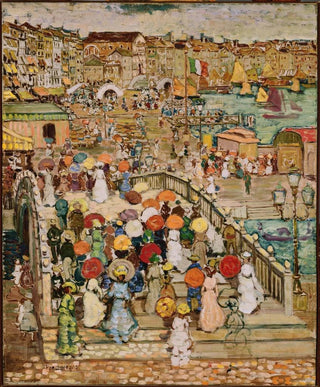Art print | Straw Bridge - Maurice Prendergast


View from behind

Frame (optional)
Pont de paille - Maurice Prendergast – Engaging introduction
In the vibrant world of American Impressionism, the artwork "Pont de paille" by Maurice Prendergast stands out for its ability to capture light and movement with rare delicacy. This canvas, evoking a bucolic and peaceful scene, transports the viewer to the heart of a lively nature, where colors intertwine to create an atmosphere that is both serene and dynamic. Contemplating this piece, one feels invited to immerse oneself in a world where time seems suspended, where each brushstroke tells a story, and where the beauty of landscapes is celebrated with palpable intensity.
Style and uniqueness of the artwork
Maurice Prendergast's style is characterized by a palette of vibrant colors and a bold painting technique unique to him. In "Pont de paille," shimmering shades of green, blue, and orange blend harmoniously, creating a lively tableau that captures the eye. The forms are often stylized, almost abstract, allowing the artist to transcend mere representation of reality and offer a poetic vision of nature. The characters, though present, seem to blend into the scenery, as if they are an integral part of this idyllic landscape. This approach gives the work a lightness and fluidity that evoke joy of living and escapism. Prendergast, through his use of colors and shapes, manages to capture the very essence of summer, a fleeting moment one wishes to prolong.
The artist and his influence
Maurice Prendergast, born in 1858 in Saint-Jean, Canada, is considered one of the pioneers of American Impressionism. His artistic journey is marked by travels to Europe, where he discovered the masters of the Impressionist movement, notably Monet and Renoir. These influences are reflected in his work, but Prendergast also develops a unique style, blending elements of American tradition with European inspirations. His ability to incorporate scenes of everyday life with natural landscapes demonstrates a particular sensitivity to the harmony between man and his environment. Beyond his personal production, Prendergast played a crucial role in the

Matte finish

View from behind

Frame (optional)
Pont de paille - Maurice Prendergast – Engaging introduction
In the vibrant world of American Impressionism, the artwork "Pont de paille" by Maurice Prendergast stands out for its ability to capture light and movement with rare delicacy. This canvas, evoking a bucolic and peaceful scene, transports the viewer to the heart of a lively nature, where colors intertwine to create an atmosphere that is both serene and dynamic. Contemplating this piece, one feels invited to immerse oneself in a world where time seems suspended, where each brushstroke tells a story, and where the beauty of landscapes is celebrated with palpable intensity.
Style and uniqueness of the artwork
Maurice Prendergast's style is characterized by a palette of vibrant colors and a bold painting technique unique to him. In "Pont de paille," shimmering shades of green, blue, and orange blend harmoniously, creating a lively tableau that captures the eye. The forms are often stylized, almost abstract, allowing the artist to transcend mere representation of reality and offer a poetic vision of nature. The characters, though present, seem to blend into the scenery, as if they are an integral part of this idyllic landscape. This approach gives the work a lightness and fluidity that evoke joy of living and escapism. Prendergast, through his use of colors and shapes, manages to capture the very essence of summer, a fleeting moment one wishes to prolong.
The artist and his influence
Maurice Prendergast, born in 1858 in Saint-Jean, Canada, is considered one of the pioneers of American Impressionism. His artistic journey is marked by travels to Europe, where he discovered the masters of the Impressionist movement, notably Monet and Renoir. These influences are reflected in his work, but Prendergast also develops a unique style, blending elements of American tradition with European inspirations. His ability to incorporate scenes of everyday life with natural landscapes demonstrates a particular sensitivity to the harmony between man and his environment. Beyond his personal production, Prendergast played a crucial role in the






